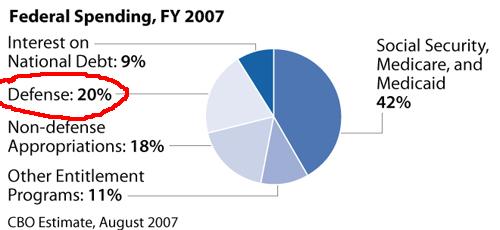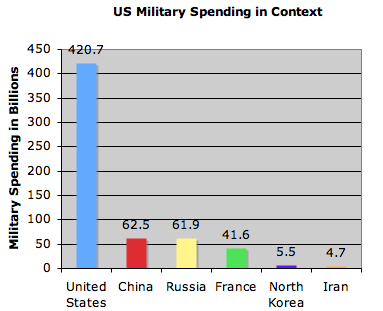These two graphs on United States defense spending are worth 2000 words:
Yeah, there's a war on terrorism and we're in Iraq and Afghanistan, but do we really need to spend over $400 billion, or 20% of our budget on defense?
Now, defense secretary Robert Gates' proposed defense budget hasn't actually cut defense spending, but he seems to have his focus in perspective. Gone are wasteful Cold War defense programs. Gone are huge expenditures for, say, revamping the Navy (I mean, think about it — to what extent is the next generation of submarines going to keep this country save against terrorists? Not much). Huge missile defense "shields" are scaled back to more realistic missile defense programs.
The Reality-Based Community's Mark Kleiman gives some specifics:
"New DoD budget in brief: Less F-22's, gold-plated Presidential helicopters, cruisers, amphibians, aircraft carriers, missile defense. More Predator drones, intelligence/ surveillance/ reconnaissance, special forces, Army choppers, F-35s, F-18s. You'd almost think that this budget was planned in the interests of national security rather than either defense contractor and lobbyist satisfaction or providing new toys for the boys. So far, Obama's decision to keep Gates is looking pretty good."
Gates' emphasis seems to be on counterinsurgency programs — i.e., programs specifically tailored to the present threat to the United States which aren't in the form of great nations like the "Soviet Menace":
Gates shifted the budget request to allow for institutionalized support for irregular warfare — a key goal of the generation of counterinsurgency theorist-practitioners who have emerged from Iraq and Afghanistan. Support for programs desired by counterinsurgents, such as training and mentoring partner militaries in counterinsurgency, have been funded through ad-hoc budgeting during the two wars, but Gates heralded an end to that practice. “Our contemporary wartime needs must receive steady long-term funding and a bureaucratic constituency similar to conventional modernization programs,” he said. Training partner militaries, for instance, will be part of a $500 million effort to “boost global partnership capacity efforts.”
Seems like a win-win. Better defense for (one hopes in the future) less money.
UPDATE: AmericaBlog correctly sees this as a "Nixon going to China" moment.


